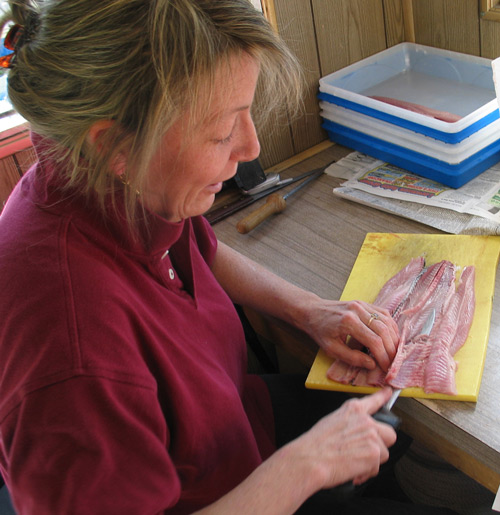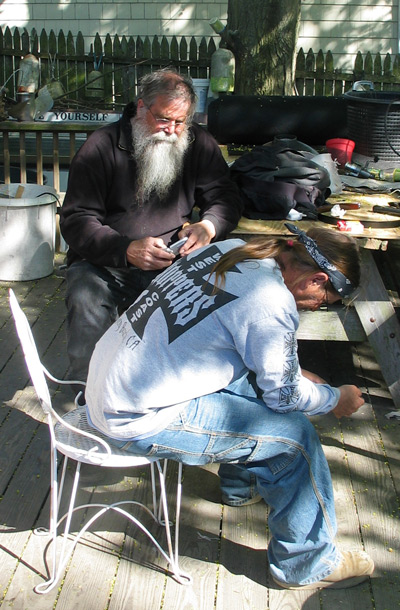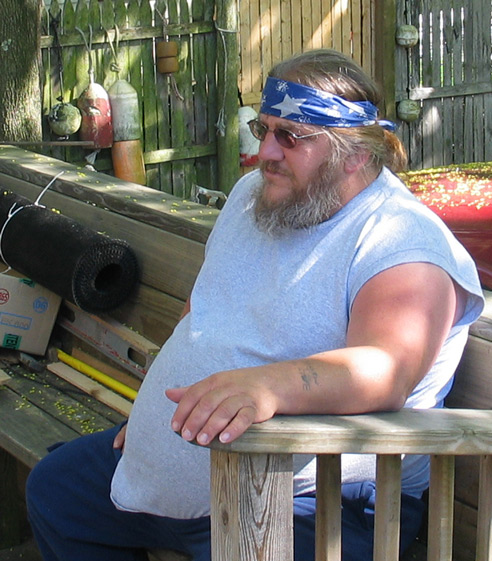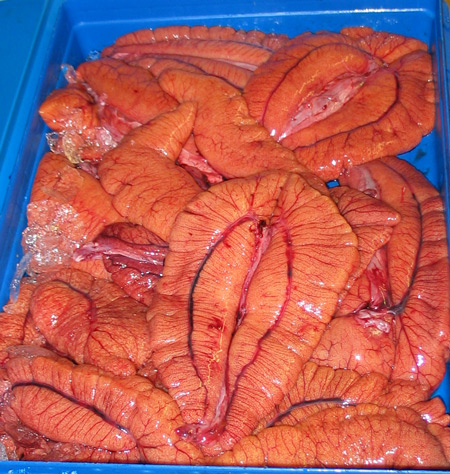Every Spring the cold waters of the Connecticut river draw spawning shad for a few weeks of spring fever. And for centuries fishermen have tried to catch them. The American shad has a fine, delicate taste and an exasperating number of bones. Don’t even think of boning it yourself. The shad has been fought over by zealous fishermen, derided, in times of profusion, as low-class eating, and for many years dropped to a troublesome scarcity. Long ago they took 5000 fish a day, unheard of now but the shad is making a comeback. Five males are chasing every female this spring. She releases the eggs they fertilize, spawning several times. The eggs hatch in a few days and in a month they are teenagers.
Driving over the Baldwin Bridge few people are aware of the fishing community below them. Only a hand painted sign on a piece of plywood points to Ted’s Bait shop off Ferry road, where at certain hours men of pirate-like independence and appearance can be found trading misinformation, half-truths, and downright fabrications about last night’s catch. I have been a customer for Ted’s shad for years and when I asked about the fishing they offered to take me out with them. Carl Ruitto who runs the bait store warned me in no uncertain terms to dress warm. “It ain’t just cold,” he said “It’s @#%*ing cold!” So I showed up ready for the Antarctic.
Even so I was a little disconcerted when I arrived to watch young Will Tucker putting on layer after layer of clothing. Will and John Rogers are the crew. .
The tide wasn’t due to turn for an hour so we waited. We want the net to drift seaward on the tide. “Fishing’s all about the moon and tides,” says Ted. “Moon up, moon down – any moon is good.” Ted and John nod agreement, both men have full gray beards, a testament to their experience. Reading the river is what they do, and years of fishing has bred an air of calm about them. “You sure you’re warm enough?” they keep asking me, and I assure them I am. They are completely covered, head to toe, in heavy waterproofs.
“Most of the time’s spent preparing: nets, boat, cleaning the fish, regulations.
It’s a relief to get out on the river.” Ted fires up the engine and turns the boat out of the dock. It’s a small craft, maybe 20 feet by 6 feet, it sits low on the water and is ruggedly made of fiberglass. The net stretches the length of the deck. It is mono-filament, a thin, almost invisible, fiber line and comes in sections, called ‘snappers’ – not after the fish but because they snap together. Each section is about 200 feet long by 18 feet deep, and the grid is a diamond pattern. At the top, every six feet, is a float – a corker – and at the bottom, weighing it down is a metal ring. Ted has five ‘snappers’ on tonight so his net is a little over a thousand feet long.
We settle near an abutment of the railroad bridge and wait for the tide. After a while another fishing boat arrives. From above a cantankerous railroad official yells at us to keep away from the bridge but none of the boats are touching anything. The fishermen shake their heads.
By agreement, when the time is right for setting the nets, the boats move out by order of arrival. We sail south into the broader estuary. The corkers are in the bow where Will has perched himself on the side of the boat. The rings are in the stern neatly stacked on a cone. John has the first few in his hands ready to throw. Starting in the east we make our way west across the river. Will and John feeding net into the water in steady, coordinated dance routine while Ted paces the rhythm of the boat. Every now and then he flashes a powerful light across the surface to check the lengthening line of corkers. He is steering the boat so as to put a curve ‘a belly’ in the net that will lead the drift south.
After ‘setting’ the net Will Tucker rests while waiting for the ‘take’.
Suddenly the flurry of activity is over, the net is set and we are quiet, aware of the night. It was a warm day for early May and night is clear and pleasant. We can see the traffic moving across the Baldwin Bridge but hear nothing save the lapping water and Eleanor Rigby coming through a cloud
of static on the small radio. Ted points out a green blinking light away south in the darkness. It’s our boundary. The river bed changes there and all kinds of refuse that have fallen into the water have accumulated and lie there in wait for the nets. The river is running slow tonight. We drift with the net and talk. We talk about the oyster beds along the bank of Great Island, about the best boats, the monster sturgeon they pulled in last night – five feet long, easy. They are not allowed to keep the sturgeon or the stripers of any size, they have to go back .
John Rogers talks about growing up a surfer in San Diego, and his roofing business in San Francisco. He tells us about his great grandfather an inventor with a fist full of patents and his mother who skated in the 1932 Lake Placid Olympics. Ted checks his net with the light. If we snag a tree limb or an old buoy threatening disaster then that section
‘snapper’ is unhooked so the snarl won’t take the whole net. We’ve been lucky tonight.
On the river it’s hard to tell the lights on the water from those on shore. Ted points out the few boats that are out tonight. Time was, when he was young, he couldn’t count the number of fishing boats working the river. Now, he counts off on his fingers, he can only think of eight. The young don’t take to fishing. People hardly know what shad is anymore. He feels he’s keeping a dying tradition alive. Fate. It’s a feeling I heard next day when I went to watch Nina Johnston the ‘Shad Queen’ bone the fish. Nina is a high spirited, outgoing blonde who banters happily as she slices out the bones – over a thousand of them in 30 cuts – about two minutes per fish. Her knives are quick and very sharp and remarkably there’s not a scar on her hands. She learnt the skill as the child of a fishing family and as the season is so short it’s not a job, it’s more about the tradition.
We have have drifted quite a way and now suddenly I feel chilled to the bone. Every little breeze has a cutting edge to it. The moon has failed to show, and we’re closing in on the green blinker. Ted decides it’s time to take. Will and John ready themselves at the side of the boat. As if orchestrated The Rolling Stones’ Street Fighting Man crackles through the radio static and from calmly drifting we are suddenly thrown into frenzied activity.
Fish are coming into the boat. Big fish. Lively, scrappy fish. John and Will pull in the net with the same coordination they threw it out only now they stop between pulls to release the fish. It’s hard, grueling work. The fish fight and they are strong. The toughest are the big striped bass, maybe 20 – 30 pounds, and they have to be thrown right back. With each pull at the net more fish come into the boat, and I eagerly watch for any sign of the big sturgeon. There’s no time for rest the net and boat alike are steadily drifting toward the green blinker. At times the work seems overwhelming. Exhausting. And there is always more and more net to pull in.
Ted is watching the river. Like the weather contradicting the forecast the tide has turned off schedule and the tail end of the net is moving back upstream. With the last of their strength the men haul in the rest of the net, and then fall back to catch their breath. There are about a hundred shad in the boat, and about as many stripers thrown back. But no sturgeon tonight. With the changing tide they decide to call it a night and we head back to dock. I don’t mention that I am frozen to the core.

Nina Johnston, ‘The Shad Queen’ to her friends, makes 30 cuts in about 2 min- utes to fillet the boney shad.

Will Tucker pulls in the net






